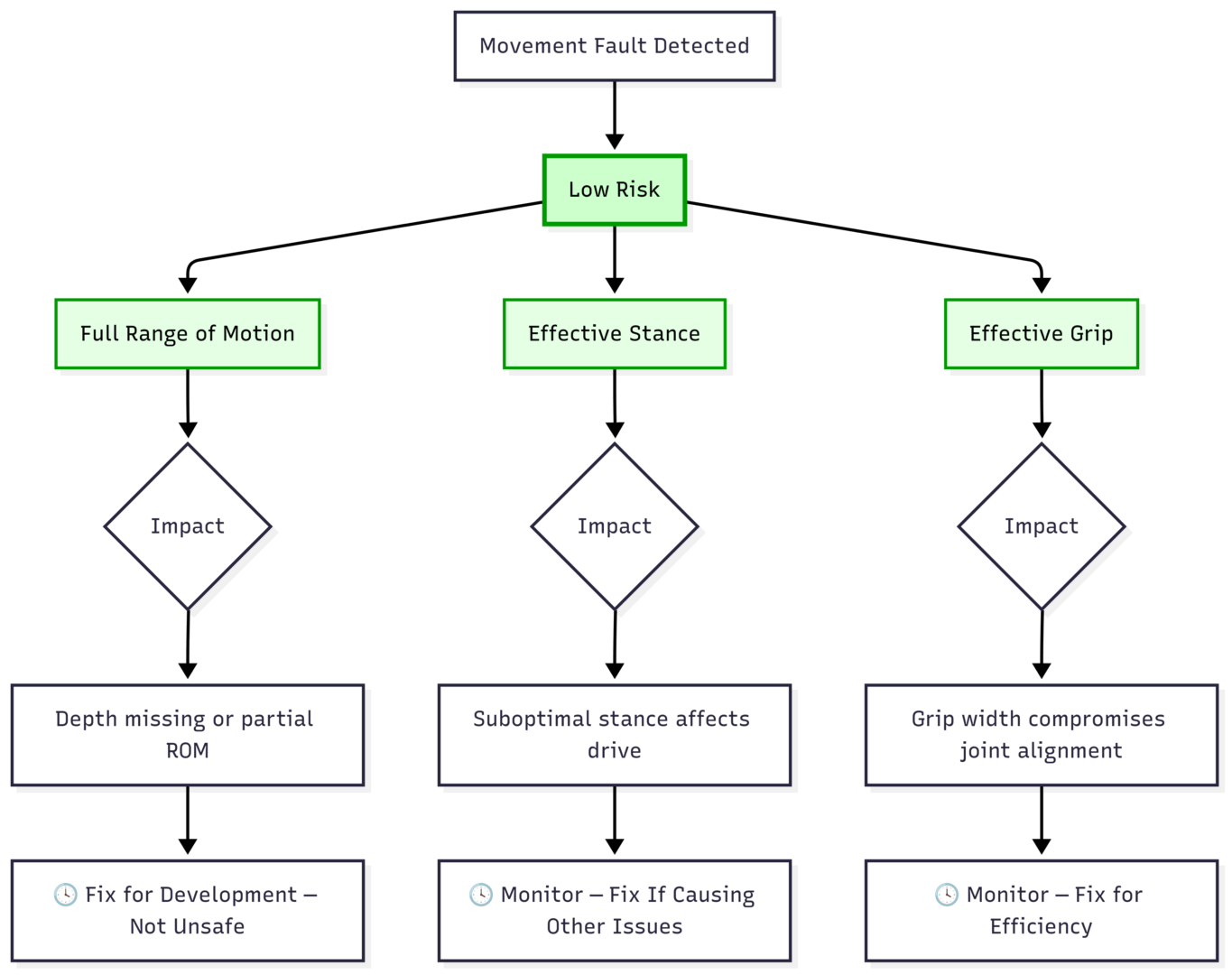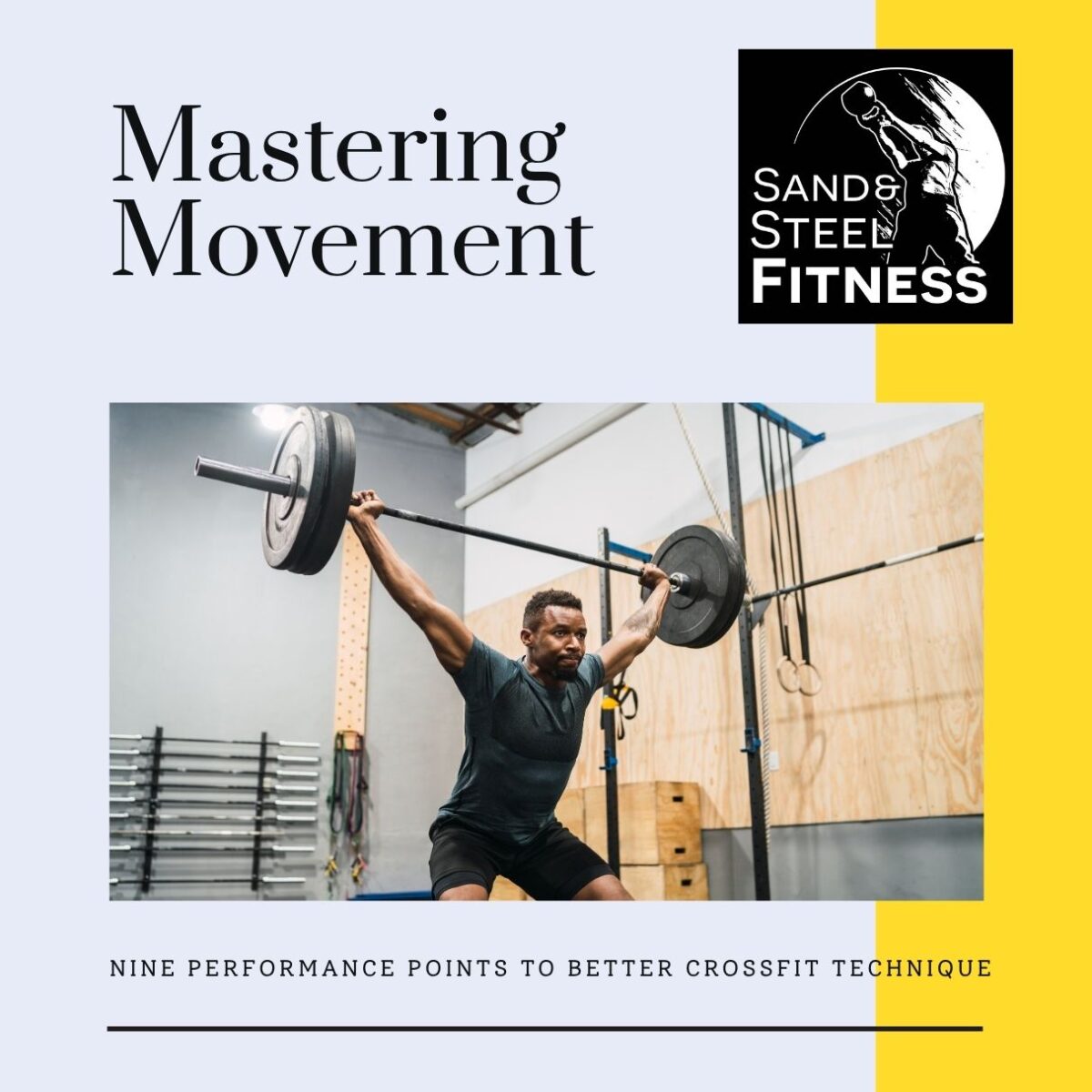Introduction
Rapidly identifying and correcting movement faults is essential for athlete safety and performance optimization. Poor technique creates power leaks and increases injury risk. This guide teaches you to categorize movement faults systematically, enabling effective coaching decisions about which errors to prioritize and how to correct them.
High Risk, Medium Risk, and Low Risk Faults



Movement Fault Assessment Guide
| 🔴 HIGH RISK – Immediate Safety Concerns | |||
| Point of Performance | Impact Level | Indicators | Action Required |
| Midline Stabilization | Critical | Dynamic spinal movement under load Static deviation from neutral spine Slight postural drift | ⚠️ Immediate Correction Required |
| Posterior Chain Engagement | Critical | Knee collapse or heel rise under load Weight shifts forward slightly Minor imbalance | ⚠️ High Priority Correction |
| Sound Hip Function | Critical | Muted hip or hip never flexes Incomplete extension Slow or delayed hip drive | ⚠️ Fix to Prevent Injury & Compensation |
| 🟡 MEDIUM RISK – Efficiency & Compensation Issues | |||
| Point of Performance | Impact Level | Indicators | Action Required |
| Core-to-Extremity Movement | Moderate | Arms move before hips finish Timing slightly off | ⚠️ Fix to Restore Efficiency |
| Balance About Frontal Plane | Moderate | Bar drifts forward of mid-foot Slight center of mass shift | ⚠️ May Lead to Spinal Compensation |
| Active Shoulders | Moderate | Shoulders yield in direction of load Scapular engagement weak | ⚠️ Fix to Protect Shoulders |
| Line of Action | Moderate | Bar path inefficient or looping Slight horizontal displacement | ⚠️ Correct for Load Management |
| 🟢 LOW RISK – Development & Optimization | |||
| Point of Performance | Impact Level | Indicators | Action Required |
| Full Range of Motion | Low | Depth missing or partial ROM | 🕓 Fix for Development — Not Unsafe |
| Effective Stance | Low | Suboptimal stance affects drive | 🕓 Monitor — Fix If Causing Other Issues |
| Effective Grip | Low | Grip width compromises joint alignment | 🕓 Monitor — Fix for Efficiency |
CrossFit Movement Analysis: Core Points of Performance
Introduction
Rapidly identifying and correcting movement faults is essential for athlete safety and performance optimization. Poor technique creates power leaks and increases injury risk. This guide teaches you to categorize movement faults systematically, enabling effective coaching decisions about which errors to prioritize and how to correct them.
The Ten Core Points of Performance
All foundational movements—from basic patterns to advanced skills like the snatch and kipping pull-up—share common points of performance. These standards provide a framework for evaluating any movement:
- Midline Stabilization
- Core-to-Extremity Movement
- Balance About the Frontal Plane
- Posterior Chain Engagement
- Sound Hip Function
- Active Shoulders
- Full Range of Motion
- Effective Stance
- Effective Grip
- Line of Action
1. Midline Stabilization
Definition: The ability to maintain the spine’s natural S-curve and prevent unwanted spinal movement during loaded or dynamic activities.
Key Muscles: Abdominals, obliques, and erector spinae create a muscular belt around the vertebrae.
Performance Benefits:
- Enables force transmission between appendages and external objects
- Maintains torso as a rigid, integrated structure
- Optimizes muscular and skeletal alignment for force distribution
Safety Hierarchy (from safest to most dangerous):
- Neutral spine maintained throughout movement (safest)
- Static non-neutral position (moderate risk)
- Dynamic loss of neutral spine (highest risk)
Common Faults:
- Lumbar flexion under load: Lower back rounds from concave to convex
- Hyperextension: Excessive backward bending, often seen in overhead movements
- Dynamic spinal movement: Starting neutral then flexing significantly during the lift
Coaching Notes: Hyperextension typically indicates insufficient abdominal engagement and can be addressed by cueing athletes to “tighten the abs.”
2. Core-to-Extremity Movement
Definition: A muscular contraction sequence beginning with large, force-producing core muscles and ending with smaller, high-velocity extremity muscles.
Movement Pattern:
- Initiation: Core and hip muscles establish the foundation
- Transmission: Force transfers through the kinetic chain
- Completion: Extremities (arms, calves, hands) finish the movement
Performance Benefits:
- Maximizes force development by engaging largest muscles first
- Improves efficiency and total work capacity
- Reduces injury risk to smaller muscle groups
Common Faults:
- Arms moving before hips and legs complete extension
- Pulling or pushing early in dynamic movements
- Insufficient core engagement compromising force transfer
3. Balance About the Frontal Plane
Definition: Maintaining the athlete and load positioned relative to an imaginary plane that bisects the body at mid-foot.
Key Principle: Objects should travel in straight lines when possible, following the shortest distance between two points.
Performance Benefits:
- Increases efficiency through optimal load path
- Maintains balance and stability
- Reduces compensatory movements
Application Examples:
- Squat: Hips move back and down to keep bar over mid-foot
- Kipping Pull-up: Center of mass oscillates about the plane from hands to floor
Safety Note: While deviations aren’t inherently dangerous, they often trigger other movement errors like spinal flexion.
4. Posterior Chain Engagement
Definition: Active contribution of muscles on the body’s posterior side—hamstrings, glutes, and spinal erectors.
Key Indicators:
- Foot pressure: Balanced between balls of feet and heels
- Knee alignment: Knees track in line with toes
- Weight distribution: Load remains close to frontal plane
Performance Benefits:
- Maximizes power generation through large muscle groups
- Improves efficiency by keeping load close to center of gravity
- Supports optimal knee mechanics and full range of motion
Common Faults:
- Forward weight shift: Excessive pressure on balls of feet
- Knee collapse: Knees cave inward, especially under fatigue
- Premature heel rise: Heels lift too early in explosive movements
Coaching Insight: Athletes who demonstrate knee collapse in squats typically show this fault to varying degrees in all knee-flexion movements.
5. Sound Hip Function
Definition: The ability to fully flex and extend the hips to maximize their contribution to movement.
Critical Elements:
- Complete hip flexion: “Closing” the hip angle appropriately
- Full hip extension: Achieving complete extension at movement completion
- Explosive hip extension: Rapid, powerful hip drive for acceleration
Performance Impact:
- Applies maximum force to the object
- Creates optimal elevation and acceleration
- Utilizes the body’s most powerful muscle groups
Common Faults:
- Muted hip: Hip never fully flexes, creating quad-dominant movement
- Incomplete extension: Failure to achieve full hip extension
- Slow extension: Insufficient speed in hip drive
6. Active Shoulders
Definition: The most stable shoulder position when working against load, achieved through appropriate scapular position and stabilization.
Key Principle: Apply force in the direction opposite to the load while maintaining natural shoulder positioning.
Movement-Specific Applications:
- Overhead movements: Push up into the load
- Ground-based movements: Push down into the surface
- Pulling movements: Pull back to prevent forward rounding
Benefits:
- Optimizes skeletal alignment and muscle recruitment
- Reduces impingement risk by creating space in the shoulder joint
- Enables maximum force transfer through the torso
Common Fault: Shoulders yielding in the same direction as the applied load.
7. Full Range of Motion
Definition: Moving through the complete, natural anatomical range of a joint during exercise.
Benefits:
- Engages maximum muscle groups and joint structures
- Develops strength at all joint angles
- Maintains mobility and prevents deficiencies
- Prepares athletes for real-world movement demands
Key Principle: Preserve full range of motion above other considerations (load, speed) unless more pressing safety issues exist.
Caution: Avoid hyperextension or artificially forced range of motion beyond natural anatomical limits.
8. Effective Stance
Definition: The foot position adopted during movement that promotes optimal task accomplishment and supports all other points of performance.
Common Stance Variations:
- Narrow stance (hip width): Used in deadlifts, presses, and Olympic lifts for more direct force transfer through heels to the object
- Wide stance (shoulder width): Used in squatting movements to allow greater depth and posterior chain contribution
Performance Benefits:
- Optimizes force transfer efficiency
- Enables proper range of motion
- Supports other movement themes (balance, posterior chain engagement)
Special Considerations:
- Wider stances may sacrifice some force-transfer efficiency but gain function and range of motion
- Stance can be modified for specific loading mechanics (e.g., sumo deadlift)
- Athletes must learn to apply other points of performance regardless of stance used
Safety Note: No major safety concerns except when stance adversely affects other points of performance.
9. Effective Grip
Definition: The hand position that optimizes force application, stability, and control while supporting all other movement requirements.
General Principles:
- Usually positioned outside shoulders or hips to avoid interference
- Width adjusted based on movement demands (wider for snatch, narrower for deadlift)
- Must support rather than compromise other points of performance
Performance Benefits:
- Ensures safe and effective force application
- Supports stability and control throughout movement
- Enables proper joint alignment and force transfer
Real-World Applications:
- Athletes must adapt grip to accommodate odd objects and non-ideal situations
- Grip modifications should be assessed based on their effect on all other movement themes
Safety Note: Like stance, grip itself poses no major safety concerns unless it negatively impacts other points of performance.
10. Line of Action
Definition: The path that the load travels during movement, optimally maintained as a straight line over the mid-foot.
Key Principle: Objects should travel the shortest distance between two points when possible, maximizing efficiency and minimizing energy expenditure.
Performance Benefits:
- Maximizes movement efficiency
- Maintains balance and stability
- Minimizes unnecessary energy leaks
- Reduces compensatory muscle activation
Common Applications:
- Squat: Bar travels vertically over mid-foot
- Deadlift: Bar maintains close proximity to body throughout lift
- Press: Bar travels straight up from starting position
- Snatch: Bar follows efficient path from floor to overhead
Common Faults:
- Bar drifting forward or backward during movement
- Horizontal displacement requiring compensatory movements
- Inefficient load paths that waste energy and reduce power output
Coaching Focus: When line of action is compromised, athletes must compensate with additional muscle activation, reducing both power output and movement efficiency.
Risk Assessment Framework
Movement safety and performance must be evaluated considering four factors:
- Athletic Capacity: The individual’s current ability level
- Loading: Weight or resistance being used
- Positioning: How far from optimal position the athlete operates
- Assigned Tasks: The specific movement demands
Key Insight: The same position may be safe for one athlete but dangerous for another based on these contextual factors.
Coaching Applications
Fault Prioritization
When multiple faults appear simultaneously, prioritize corrections based on:
- Safety risk: Address dangerous positions first
- Performance impact: Focus on faults limiting power output
- Prerequisite relationships: Some corrections enable others
Training Philosophy
Emphasize proper mechanics regardless of load to develop sound motor patterns. As athletes advance, the margin for error decreases, making technical precision increasingly critical for both safety and performance.
Progressive Development
Challenge athletes to improve beyond their current capacity while maintaining safety. Small improvements in positioning can yield significant gains in loading potential and movement efficiency.
Summary
These ten core points of performance provide a systematic framework for analyzing and improving athletic performance. By understanding how each point contributes to safety, efficiency, and effectiveness, coaches can make informed decisions about movement correction and athlete development. The key is consistent application of these principles across all movements, loads, and skill levels.
